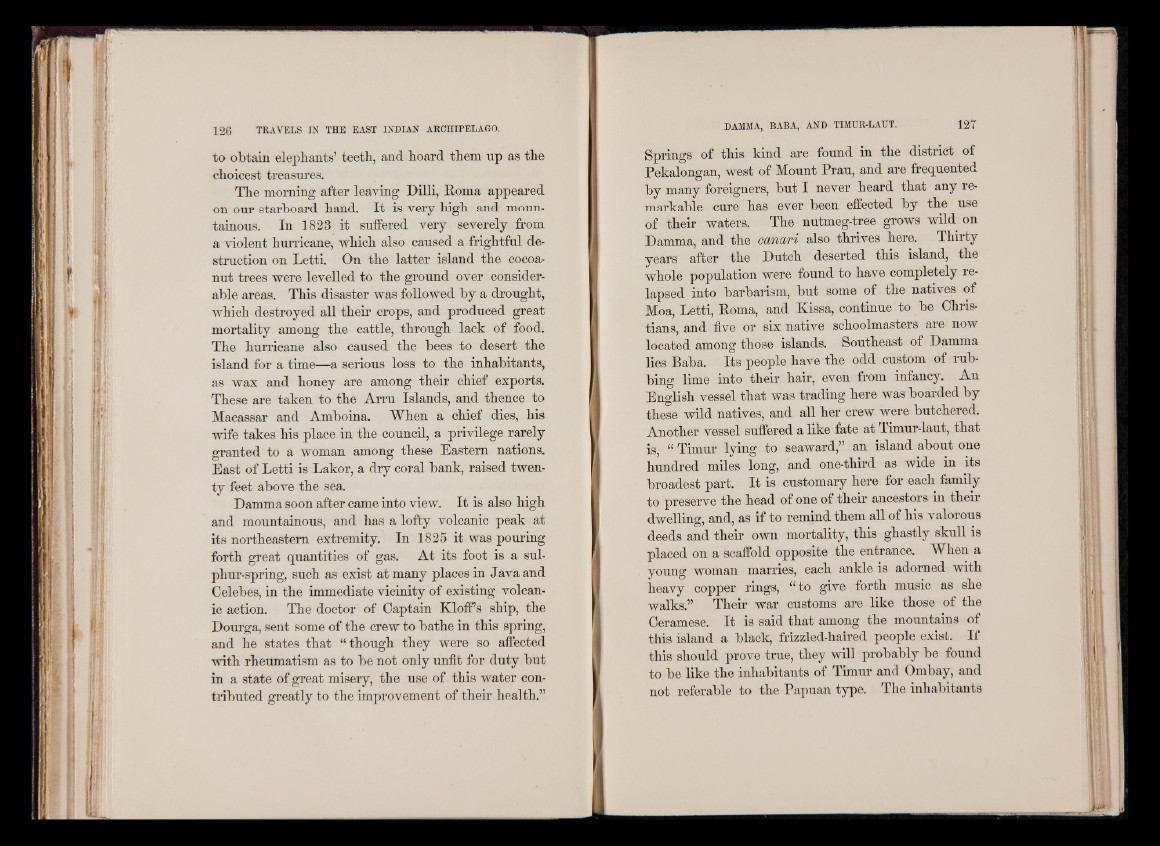
to obtain elephants’ teeth, and hoard them up as the
choicest treasures.
The morning after leaving Dilli, Roma appeared
on our starboard hand. It is very high and mountainous.
In 1823 it suffered very severely from
a violent hurricane, which also caused a frightful destruction
on Letti. On the latter island the cocoa-
nut trees were levelled to the ground over considerable
areas. This disaster was followed by a drought,
which destroyed all their crops, and produced great
mortality among the cattle, through lack of food.
The hurricane also caused the bees to desert the
island for a time—a serious loss to the inhabitants,
as wax and honey are among their chief exports.
These are taken to the Arru Islands, and thence to
Macassar and Amboina. When a chief dies, his
wife takes his place in the council, a privilege rarely
granted to a woman among these Eastern nations.
East of Letti is Lakor, a dry coral bank, raised twenty
feet above the sea.
Damma soon after came into view. It is also high
and mountainous, and has a lofty volcanic peak at
its northeastern extremity. In 1825 it was pouring
forth great quantities of gas. At its foot is a sulphur
spring, such as exist at many places in Java and
Celebes, in the immediate vicinity of existing volcanic
action. The doctor of Captain KlofPs ship, the
Dourga, sent some of the crew to bathe in this spring,
and he states that “ though they were so affected
with rheumatism as to be not only unfit for duty but
in a state of great misery, the use of this water contributed
greatly to the improvement of their health.”
Springs of this kind are found in the district of
Pekalongan, west of Mount Prau, and are frequented
by many foreigners, but I never heard that any remarkable
cure has ever been effected by the use
of their waters. The nutmeg-tree grows wild on
Damma, and the canari also thrives here. Thirty
years after the Dutch deserted this island, the
whole population were found to have completely relapsed
into barbarism, but some of the natives of
Moa, Letti, Roma, and Kissa, continue to be Christians,
and five or six native schoolmasters are now
located among those islands. Southeast of Damma
lies Baba. Its people have the odd custom of rubbing
lime into their hair, even from infancy. An
English vessel that was trading here was boarded by
these wild natives, and all her crew were butchered.
Another vessel suffered a like fate at Timur-laut, that
is, “ Timur lying to seaward,” an island about one
hundred miles long, and one-third as wide in its
broadest part. It is customary here for each family
to preserve the head of one of their ancestors in their
dwelling, and, as if to remind them all of his valorous
deeds and their own mortality, this ghastly skull is
placed on a scaffold opposite the entrance. When a
young woman marries, each ankle is adorned with
heavy copper rings, “ to give forth music as she
walks.” Their war customs are like those of the
Ceramese. It is said that among the mountains of
this island a black, frizzled-haired people exist. If
this should prove true, they will probably be found
to be like the inhabitants of Timur and Ombay, and
not referable to the Papuan type. The inhabitants